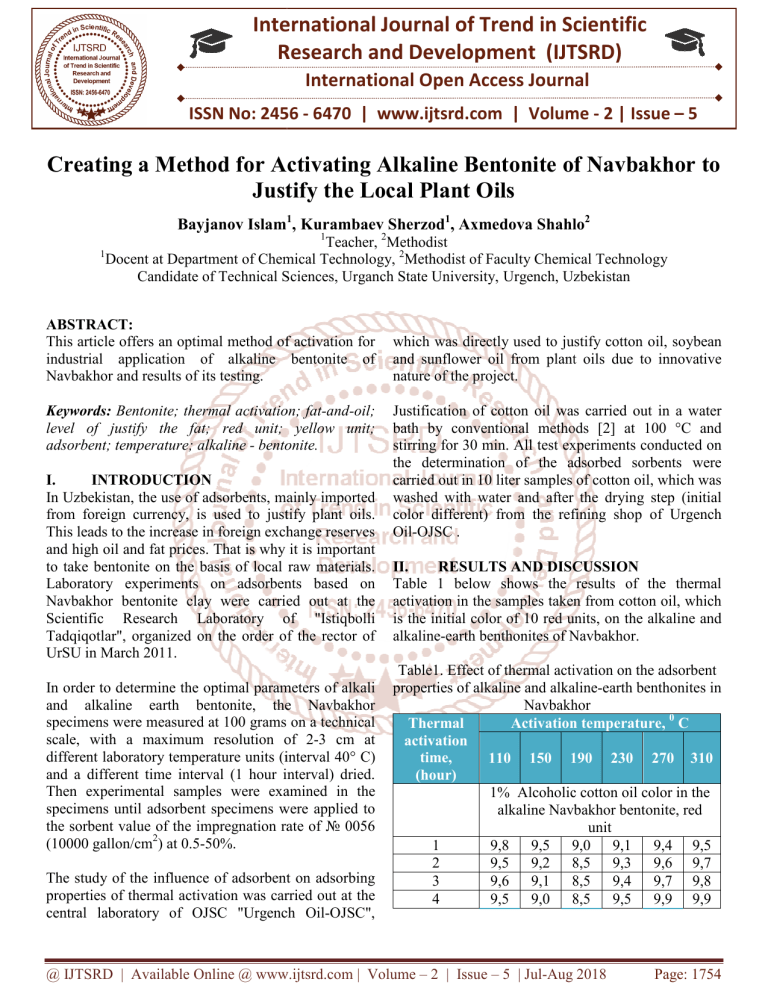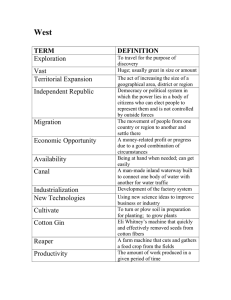
International Journal of Trend in Scientific
Research and Development (IJTSRD)
International Open Access Journal
ISSN No: 2456 - 6470 | www.ijtsrd.com | Volume - 2 | Issue – 5
Creating a Method for Activating Alkaline Bentonite of Navbakhor to
Justify tthe Local Plant Oils
Bayjanov Islam1, Kurambaev Sherzod1, Аxmedova
xmedova Shahlo2
1
Teacher, 2Methodist
1
Docent at Department of Chemical Technology, 2Methodist of Faculty Chemical Technology
Candidate of Technical S
Sciences, Urganch State University, Urgench, Uzbekistan
ABSTRACT:
This article offers an optimal method of activation for
industrial application of alkaline bentonite of
Navbakhor and results of its testing.
fat-and-oil;
Keywords: Bentonite; thermal activation; fat
level of justify the fat; red unit; yellow unit;
adsorbent; temperature; alkaline - bentonite.
I.
INTRODUCTION
In Uzbekistan, the use of adsorbents, mainly imported
from foreign currency, is used to justify plant oils.
This leads to the increase in foreign exchange reserves
and high oil and fat prices. That is why it is important
to take bentonite on the basis of local raw materials.
Laboratory experiments on adsorbents based on
Navbakhor bentonite clay were carried out at the
Scientific
entific Research Laboratory of "Istiqbolli
Tadqiqotlar", organized on the order of the rector of
UrSU in March 2011.
In order to determine the optimal parameters of alkali
and alkaline earth bentonite, the Navba
Navbakhor
specimens were measured at 100 grams on a technical
scale, with a maximum resolution of 22-3 cm at
different laboratory temperature units (interval 40° C)
and a different time interval (1 hour interval) dried.
Then experimental samples were examined in the
specimens until adsorbent specimens wer
were applied to
the sorbent value of the impregnation rate of № 0056
(10000 gallon/cm2) at 0.5-50%.
The study of the influence of adsorbent on adsorbing
properties of thermal activation was carried out at the
central laboratory of OJSC "Urgench Oil
Oil-OJSC",
which was directly used to justify cotton oil, soybean
and sunflower oil from plant oils due to innovative
nature of the project.
Justification of cotton oil was carried out in a water
bath by conventional methods [2] at 100 °C and
stirring for 30 min. All
ll test experiments conducted on
the determination of the adsorbed sorbents were
carried out in 10 liter samples of cotton oil, which was
washed with water and after the drying step (initial
color different) from the refining shop of Urgench
Oil-OJSC .
II.
RESULTS AND
ND DISCUSSION
Table 1 below shows the results of the thermal
activation in the samples taken from cotton oil, which
is the initial color of 10 red units, on the alkaline and
alkaline-earth
earth benthonites of Navbakhor.
Table1. Effect of thermal activation on the adsorbent
properties of alkaline and alkaline-earth
alkaline
benthonites in
Navbakhor
Thermal
Activation temperature,
temperature 0 С
activation
time,
110 150 190 230 270 310
(hour)
1% Alcoholic cotton oil color in the
alkaline Navbakhor bentonite, red
unit
1
9,8 9,5 9,0 9,1 9,4 9,5
2
9,5 9,2 8,5 9,3 9,6 9,7
3
9,6 9,1 8,5 9,4 9,7 9,8
4
9,5 9,0 8,5 9,5 9,9 9,9
@ IJTSRD | Available Online @ www.ijtsrd.com | Volume – 2 | Issue – 5 | Jul-Aug 2018
Page: 1754
International Journal of Trend in Scientific Research and Development (IJTSRD) ISSN: 2456-6470
Thermal
activation
time,
(hour)
1
2
3
4
Activation temperature, 0 С
110
150
190
230
270
310
1% Alkali, cotton bloom in
Navbakhor bentonite, colorful,
cotton, red unit
9,9 9,8 9,7 9,6 9,7 9,8
9,8 9,7 9,5 9,7 9,8 9,8
9,8 9,6 9,5 9,8 9,8 9,9
10,
9,7 9,5 9,5 9,8 9,9
0
In Table 1 above, the adsorbing ability of the alkaline
bentonite of Navbakhor significantly increased as a
result of thermal treatment, and the optimum
parameter for this was the drying temperature of 190210 0C, drying time – 2 hours. It is also clear from this
table that Navbakhor's alkaline-earth benthonite
adsorption capability has increased dramatically by
thermal treatment.
Further research the Navbakhor alkaline bentonite
activation method has been maintained at Navbakhor
alkaline bentonite, which has the highest whiteness
rate, drying time of 2 hours, and drying temperature
of 190-2100C, which is thermally activated under
optimal conditions.
The residue remaining in the sieve was 0.5% in the
range of 3600 g/cm 2, 6000
g/cm 2 and 10,000
gallon/cm2 in order to compare the whiteness ratio of
the first 10 cotton red oils tested. It was observed that
the color of the cottonseed oil was up to 9.5 red units,
6000 gallon/cm 2 samples (1%), and the color of the
cottonseed oil was reduced to 9.0 red units at 3600
s/cm 2 samples (1%).
Considering that the fractions of less than 0.001 mm
have a high adsorbing ability [1] and that the fraction
can increase the filtration time by 1.5 times, the
residual dampness level of 10,000 gollon/cm2 should
remain 0.5 to 25% was adopted.
Also, the effect of mixing the adsorbent and cotton oil
at the constant temperature (100 0C) on the samples of
the alkaline bentonite of Navbakhor in thermally
activated conditions under the optimal conditions was
assessed on the degree of justification of the initial
color cotton oil oil equal to 10 red units. The results
are shown in Table 4 below.
Table 2. Influence of the time of mixing the alkaline
bentonite of the Navbakhor with the thermal
activation on cotton oil level
Mixing time, min 15 30 45 60 90
8,9 8,5 8,6 8,9 9,1
Color in red
The table above shows that the optimal mixing time is
30 minutes. In addition, the sample of the alkaline
bentonite of Navbakhor under thermally activated
conditions under various conditions was used to
justify various oils at different times. The results
obtained in Table 3 are summarized below.
Table 3. Indicators of cotton lubricants produced by
different seasons using the Navbakhor alkaline
bentonite.
American
"Pure-Flo
Quantity of
Supreme
The first cotton
experimental
B81" brand
oil color, red
amount of
and blue in the adsorbents, %
adsorbent,
equation
%
(justification
time)
1
2
3
1
2
elegant cotton oil color, in red
and blue unit
13
12
12
23 ва 2, (2011
and and and 12,0
7,5
July)
1
1
1
14 and 1, (2011
12
11
11
10
7
september)
10, (2011 June) 8,5 8,0 8,0
7,0
5,0
9, (2011
4,5 4,0 4,0
3,5
3,0
october)
19
17
18
16
28 ва 3, (2012
and and
and
and
mai)
1
1
0,5
0,5
As a result of numerous series tests, the level of
neutralization of cotton oil with Navbakhor alkaline
bentonite, activated by thermic activation, indicates
that the degree of justification of the differentiation of
cotton fiber, which is different from the original color,
produced at different times.
It should be noted that the adsorbent obtained in the
method described above has a good effect on the use
of no more than 1% in the whitening of the relatively
high initial fat content. At the same time reducing the
amount of alkaline used for refining, the higher the
@ IJTSRD | Available Online @ www.ijtsrd.com | Volume – 2 | Issue – 5 | Jul-Aug 2018
Page: 1755
International Journal of Trend in Scientific Research and Development (IJTSRD) ISSN: 2456-6470
degree of coloration (12 to 15 red units), and the
reduced cost of whitening the vegetable oil by mixing
this low cost adsorbent with high-quality adsorbents.
In addition, the adsorbent sample obtained from the
thermal activation of the Navbakhor alkaline
bentonite is difficult to cope with cotton oil (due to
increased moisture and heat acidity, as well as the
formation of new fertilizer additives in cotton seeds).
Thus, in October 2011, it was pointed out that the
yield of the samples taken from the new cotton seeds
was higher than that of adsorbents (table 3). The 1%
buster adsorbent was lowered to about $ 4.5 per
pound of cotton in the first color, and the same color
of cotton oil was paralleled by the adsorbent, It has
been recorded that 3.5.
Conclusions
III.
In summary, it can be said that the sorbent with
enough adsorbent properties can be obtained by
thermoactive activation of the alkaline bentonite of
Navbakhor. However, the degree of justification of
this sorbent for vegetable oils is slightly lower than
that of traditional sorbents, which are treated with
acid. However, this very cheap adsorbent, which can
only be obtained by thermo-activation, checks the
level of justification of vegetable oil at the factory
laboratory, and gives high economical results, with
good results and mixing with high-quality adsorbents
in the required quantity. Based on this we find that it
is not necessary to treat acids with alkaline bentonite
in Navbakhor. Considering that the alkaline-earth
benthonite activity in Navbakhor has a small increase
in thermal treatment, it is desirable to use acids to
increase its activity.
References
IV.
1. Оvcharenko F. D., Nichiporenko С. P.,
Kruglitskiy N. N., Tretinnik V. Yu. Studies in the
field of physico-chemical mechanics of dispersed
clay minerals.Kiev, 1965.178P.
2. Manual on methods of research, technochemical
control of production accounting in fat and oil
industry. Volume 6, issue 2, L., VNIIG. 1974.
"Test bleaching of vegetable oils", pp. 99-107.
@ IJTSRD | Available Online @ www.ijtsrd.com | Volume – 2 | Issue – 5 | Jul-Aug 2018
Page: 1756



